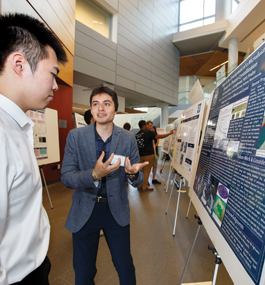A Celebration of Exploration at SciFest

Mike Lovett
The joy of learning and discovery. The passion and dedication that underlie success.
In August, the ninth annual SciFest Summer Symposium and Poster Session celebrated the pleasures and rewards of scientific exploration. In all, 123 students presented research in fields as diverse as high-energy physics and biomaterials, quantum chemistry, and fruit-fly behavior.
This year, SciFest also included four alumni talks, designed to inspire the next generation of scientists. Ronny Drapkin ’90, director of the Ovarian Cancer Research Center at the University of Pennsylvania, reminded his audience to work hard. “The amount of time you spend on the bench is, I think, directly proportionate to what you’re likely to discover,” he said.
And don’t underestimate serendipity, he added: “You have to be vigilant. You don’t know whether the next opportunity may be right under your nose.”
Leslie Meltzer ’03, vice president and head of global medical affairs at Orchard Therapeutics, a biotech company specializing in gene therapy treatments, advised students to be open to opportunities outside academia. “Don’t be afraid to step out of the box and try something new,” she said. “You won’t know what you like unless you try it.”
After the alumni spoke, students showed off their summer research in five-minute poster sessions.
Noah Somberg ’20, who was mentored by Irv Epstein, University Professor and the Henry F. Fischbach Professor of Chemistry, and associate professor of chemistry Milos Dolnik, researched Turing patterns, explaining how a simple set of chemical reactions can lead to the complex patterns found in nature — from a zebra’s stripes to the constellations of galaxies. The takeaway: By understanding how a Turing pattern develops, we may one day be able to harness nature’s properties to improve human well-being.
Janelle Mabrey was one of five Hampton University students who came to Brandeis through a summer research program funded by the National Science Foundation and Brandeis’ Materials Research Science and Engineering Center. Under the guidance of physics professor Seth Fraden, she studied light’s effect on a chemical reaction, researching a strange and fascinating phenomenon called the Belousov-Zhabotinsky (BZ) reaction, in which a combination of chemicals oscillates between two states.
A classic BZ reaction, for example, oscillates between red and blue. Certain biological functions — the firing of a neuron or electrical pulses passing through heart tissue — can be mimicked using the BZ reaction’s oscillating features. The aim of BZ research is to develop new materials that share these lifelike properties.
Jeff Liu and Michael Hsiao, both ’20, working with Leslie Griffith, the Nancy Lurie Marks Professor of Neuroscience, researched the relationship between sleep and learning in Drosophila fruit flies. They built a self-enclosed tower with a camera positioned at the top. Three motorized disks were arranged in a Y-shaped pattern near the bottom. Half of each disk contained sugar water, the other half water.
When a fly entered the tower, the camera monitored its direction. If the insect flew left, the disk spun so that the sugar water faced the animal. If the insect went right, the disk spun so that the fly found only water. Flies that flew left, in other words, got a sugary reward.
Only some of the flies figured this out. Liu and Hsiao observed that the flies that slept soon after they’d been placed into the chamber learned to head left, for the sugar water. Flies that slept later or not at all never learned that going left meant sugar. The findings echo something we know about human behavior — that getting a good night’s sleep leads to better performance during the day.
— Lawrence Goodman
